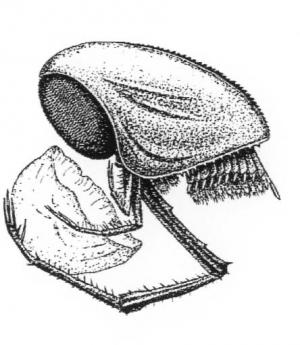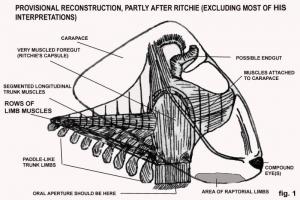Thylacocephala
The Thylacocephala (from the Greek thylakos, meaning "pouch", and cephalon meaning "head") are a unique group of extinct arthropods, with possible crustacean affinities. As a class they have a short research history, having been erected in the early 1980s.[1][2][3] They typically possess a large, laterally flattened carapace that encompasses the entire body. The compound eyes tend to be large and bulbous, and occupy a frontal notch on the carapace. They possess three pairs of large raptorial limbs, and the abdomen bears a battery of small swimming limbs. The earliest thylacocephalan fossil is thought to date from the lower Cambrian,[4] while the class has a definite presence in Lower Silurian marine communities.[5] As a group, the Thylacocephala survived to the Upper Cretaceous.[6] Beyond this, there remains much uncertainty concerning fundamental aspects of the thylacocephalan anatomy, mode of life, and relationship to the Crustacea, with whom they have always been cautiously aligned.
| ||
Virtual museum of the Czech Geological Survey, www.geology.cz, (C) Czech Geological Survey, 2011, v.0.99 [13.12.2011]


![[ENG]](img/vlajka-cr.gif) Česky
Česky 



